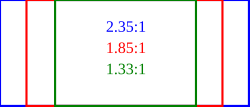Aspect ratio
Aspect ratio describes the dimensions of video screens and video picture elements. All popular video formats are rectilinear, and so can be described by a ratio between width and height. The screen aspect ratio of a traditional television screen is 4:3, or about 1.33:1. High definition televisions use an aspect ratio of 16:9, or about 1.78:1. The aspect ratio of a full 35 mm film frame with soundtrack (also known as "Academy standard") is around 2.37:1.
Ratios where the height is taller than the width are uncommon in general everyday use, but do have application in computer systems where the screen may be better suited for a vertical layout. The most common tall aspect ratio of 3:4 is referred to as portrait mode and is created by physically rotating the display device 90 degrees from the normal position. Other tall aspect ratios such as 9:16 are technically possible but rarely used. (For a more detailed discussion of this topic please refer to the page orientation article.)
Pixels on computer monitors are usually square, but pixels used in digital video often have non-square aspect ratios, such as those used in the PAL and NTSC variants of the CCIR 601 digital video standard, and the corresponding anamorphic widescreen formats. Therefore, an NTSC DV image which is 720 pixels by 480 pixels is displayed with the aspect ratio of 4:3 (which is the traditional television standard) if the pixels are thin and displayed with the aspect ratio of 16:9 (which is the anamorphic widescreen format) if the pixels are fat.


No comments:
Post a Comment